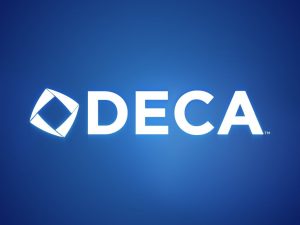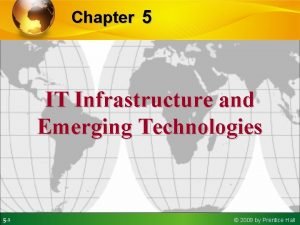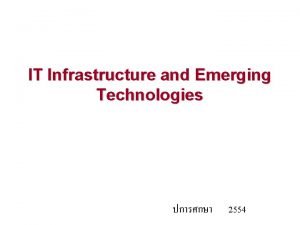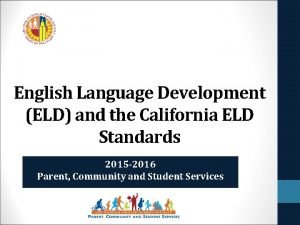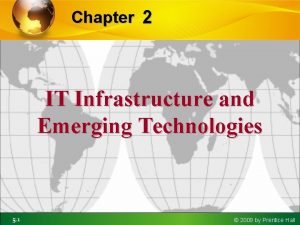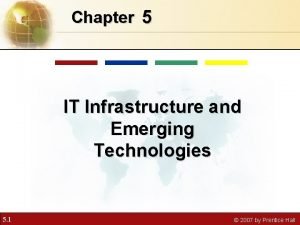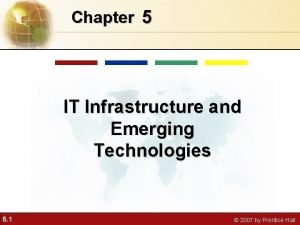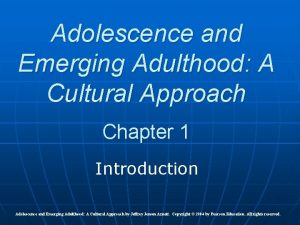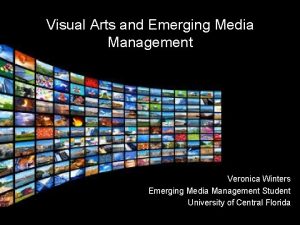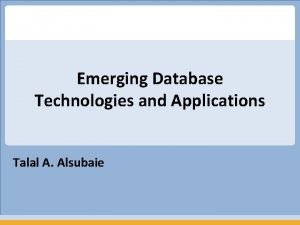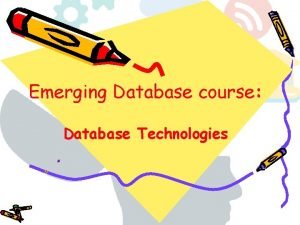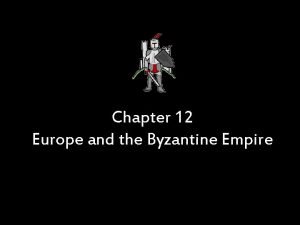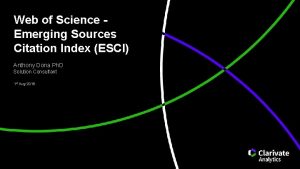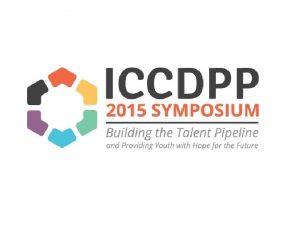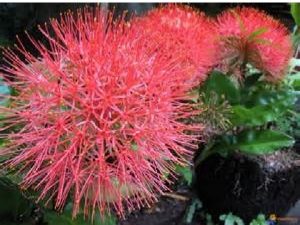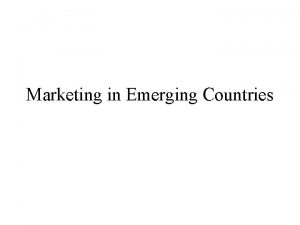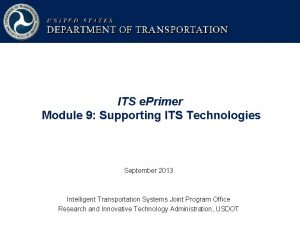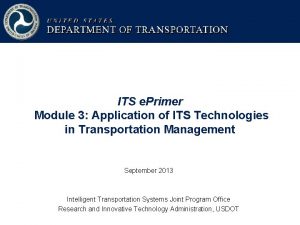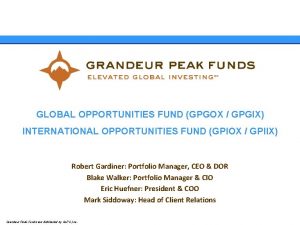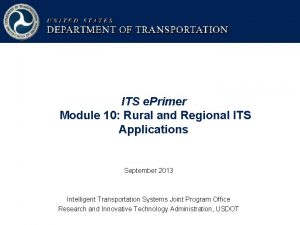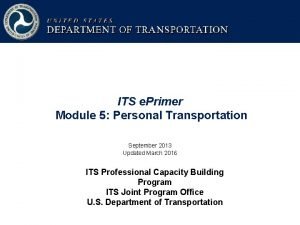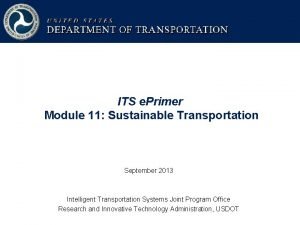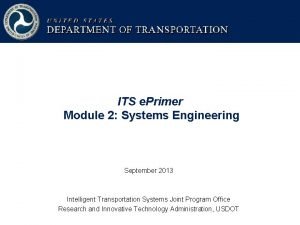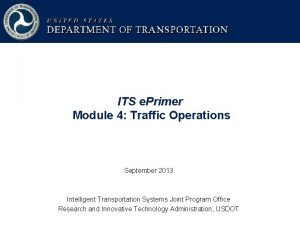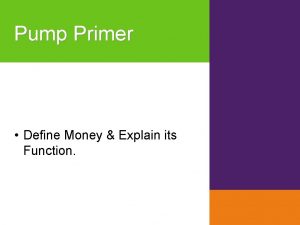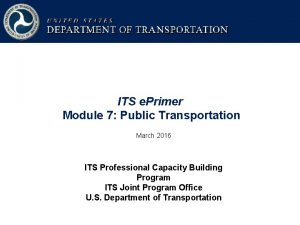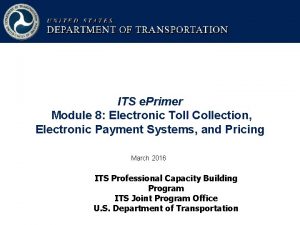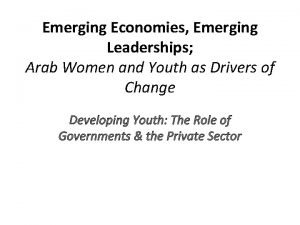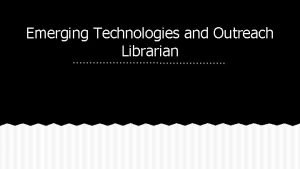ITS e Primer Module 14 Emerging Opportunities and
























- Slides: 24

ITS e. Primer Module 14: Emerging Opportunities and Challenges April 2016 ITS Professional Capacity Building Program ITS Joint Program Office U. S. Department of Transportation

Instructor Eva Lerner-Lam, F. ITE, M. ASCE Roxbury, NY, USA Co-Author Nathan E. Keyes, A. M. ASCE Beijing, China U. S. Department of Transportation 2

Learning Objectives ITS: Past, Present and Future What Are Emerging Trends That Will Affect ITS? What Are The Opportunities And Challenges For Transportation Professionals? Looking Ahead U. S. Department of Transportation 3

Purpose Understand How ITS Has Developed To Date Understand The Past, Present And Future Roles Played By The Public And Private Sectors Identify Key Technological And Societal Trends That Are Shaping The Future Of ITS Look Ahead At Possibilities In The Future U. S. Department of Transportation 4

ITS: Past, Present and Future U. S. Department of Transportation 5

6 Major Trends in Technology and Society Declining levels of federal funding Rapid societal adoption Transportation Infrastructure Distracted drivers, bicyclists and pedestrians are increasing traffic fatalities Traffic Fatalities Influencing ITS “Smart Cities” Big Data, Extreme Computing, Internet of Things, Mesh Networks, etc. Smart Phones Rapid developments Sensors and for automotive Controls use “Self-driving Vehicles” Technological advances enabling varying levels of “self-driving vehicles” U. S. Department of Transportation 6

The First 20 years of ITS (1991 -2010) Public Sector Private Sector Infra— structure 1) Maintain physical transportation infrastructure 2) Build ITS architecture and tools for “Vehicle to Infrastructure and Vehicle to Vehicle (V 2 X)” Contract services to public sector to build physical and IT infrastructures Vehicles Mandate vehicle ITS standards and Incremental improvements in safety devices to interface with ITS and reliability architectures and tools Travelers Collect traffic information to disseminate to travelers for “intelligent” travel choices Use traffic data provided by public sector to make smarter travel choices U. S. Department of Transportation 7

Technological Breakthroughs Influence the Maturation of ITS (2010 -2015) Infra— structure Vehicles Travelers Public Sector Private Sector 1) Physical: Struggling to maintain status quo 2) ITS: Transitioning from V 2 X to “Connected & Automated (sic) Vehicles” Smart Cities, Internet of Things, Big Data, Cloud Computing, Mesh Networks, etc. are rapidly creating traffic and travel data owned by the private sector NHTSA Defines Autonomous Driving Levels 1 -5 Powerful sensors, computers and controls are significantly improving collision avoidance at the individual vehicle level Disseminating enhanced public sector network traffic data by combining it with privately collected, crowd-sourced data (e. g. , WAZE, Google Maps, etc. ) ITS is shifting from system to user -optimization with high penetration of smart phones and highly accurate traffic/travel apps using crowd-sourced data U. S. Department of Transportation 8

Major Shift in Public and Private Sector Roles (2016 -Future) Public Sector Private Sector Infra— structure Focus will be on repairing and maintaining physical infrastructure (including ordinary traffic engineering and signage as well as expanding intelligent traffic signal systems to improve traffic flow) Transportation Networks will become elements of Smart Cities, and the private sector will own much of the data Vehicles Will promote advances in collision avoidance systems to reduce V 2 V and “Vehicle-to-Pedestrian” (V 2 P) collisions Vehicles will become Internet Protocol (IP) nodes, collecting data for Smart Cities companies Step up efforts to reduce collisions resulting from distracted driver and distracted pedestrians/bicycles. Travelers will make trip choices based on user-optimized constraints, subject to algorithms used by private companies providing crowd-sourced traffic information and navigation services Travelers U. S. Department of Transportation 9

Summary/Looking Ahead U. S. Department of Transportation 10

Summary Private Sector will lead investment in ITS infrastructure, vehicles and travelers Public Sector will strive to ensure safe and reliable physical infrastructure Looking Ahead Society as a whole must manage the opportunities offered by technology as well as the challenges created by those same technologies (e. g. , collisions caused by distracted travelers) U. S. Department of Transportation 11

Opportunities and Challenges for Transportation Professionals U. S. Department of Transportation 12

Opportunities and Challenges for Transportation Professionals 1 “It’s the Data” • Whomever owns transportation and traffic data will have the most influence over how ITS will evolve • Public-private partnerships that can collect, mine, clean and analyze the data together will create the potential for dramatically improving the health and well-being of our cities and urban regions U. S. Department of Transportation 13

Opportunities and Challenges for Transportation Professionals 2 “Traditional” transportation planning, design, engineering, construction, operations and maintenance are still critical • These disciplines must ”keep up” by becoming smarter, faster and less expensive with new techniques, materials, management information systems in order to continue to deliver safe and reliable infrastructure for society ITS and traditional transportation professionals must keep up with 3 technological and societal trends in order to stay relevant and productive U. S. Department of Transportation 14

References and Resources U. S. Department of Transportation 15

References § Big Data, Extreme Computing, Mesh Networks and Internet of Things □ http: //www. ciscoinvestments. com/news/veniam-announces-22 -millionseries-b-funding-disrupt-connected-vehicles-smart-cities/ □ http: //www. forbes. com/sites/bernardmarr/2016/03/15/17 -predictionsabout-the-future-of-big-data-everyone-should-read/#4 efa 3 da 8157 c □ http: //www. forbes. com/sites/louiscolumbus/2016/01/18/2016 -roundup-ofcloud-computing-and-enterprise-software-predictions/#493 d 1 ae 12230 □ http: //www. securitymagazine. com/articles/84986 -how-mesh-networksform-the-backbone-of-smart-cities □ http: //www. masstransitmag. com/blog/12125778/kinetic-mesh-networksimprove-mass-transit-communications □ http: //www. mcs. anl. gov/group/extreme-computing □ http: //www. techradar. com/us/news/internet/10 -ways-the-internet-ofthings-could-change-the-world-in-2016 -1310631 U. S. Department of Transportation 16

References (cont'd) § Data enabling Smart Cities □ https: //www. transportation. gov/smartcity □ http: //www. its. dot. gov/itspac/Dec 2014/Smart_Connected_City_FINAL_1 11314. pdf □ http: //www. vulcan. com/Areas-of-Practice/Philanthropy/Key. Initiatives/Smart-City-Challenge □ http: //smartcitiescouncil. com/smart-cities-informationcenter/transportation § Rapid societal adoption of smart phones □ http: //www. pewinternet. org/2015/04/01/us-smartphone-use-in-2015/ □ http: //www. statista. com/statistics/201182/forecast-of-smartphone-usersin-the-us/ § Apps enabled by crowd-sourced data □ https: //www. getaround. com □ https: //www. waze. com U. S. Department of Transportation 17

References (cont'd) § Rapid developments in sensors and controls for automotive use □ http: //www. iihs. org/iihs/ratings/crash-avoidance-features □ http: //www. nhtsa. gov/About+NHTSA/Press+Releases/U. S. +Department+ of+Transportation+Releases+Policy+on+Automated+Vehicle+Developme nt □ http: //www. densodynamics. com/all-about-v 2 x-talking-car-technology/ § Technological advances enabling self-driving □ http: //www. extremetech. com/tag/self-driving-cars § Declining levels of funding for transportation infrastructure □ □ http: //www. pbs. org/newshour/making-sense/highway-trust-fund-keeps-bridgesfalling-will-congress-pay-bill/ https: //www. transportation. gov/highway-trust-fund-ticker U. S. Department of Transportation 18

References (cont'd) § Distracted travelers are increasing traffic fatalities http: //www. distraction. gov □ http: //www. cdc. gov/motorvehiclesafety/distracted_driving/ □ http: //www. nhtsa. gov □ http: //bits. blogs. nytimes. com/2013/07/24/lahood-says-companies-mustwake-up-to-distracted-driving/? _r=0 □ http: //www. nytimes. com/2016/02/24/science/driving-distractionsstudy. html □ U. S. Department of Transportation 19

References (cont'd) § Professional Associations: □ American Association of State Highway Transportation Officials: http: //tig. transportation. org □ Institute of Electrical and Electronic Engineers: http: //www. comsoc. org/ □ Institute of Transportation Engineers: http: //www. ite. org/standards/index. asp □ International Bridge, Tunnel and Turnpike Association: http: //www. ibtta. org/Tollways/List. cfm □ Society of Automotive Engineers: http: //training. sae. org/seminars/c 1025/ U. S. Department of Transportation 20

References (cont'd) § Federal: □ http: //www. its. dot. gov/ □ http: //www. cdc. gov/motorvehiclesafety/distracted_drivi ng/ □ http: //www. nhtsa. gov § Media: □ http: //www. technologyreview. com/ □ http: //www. engadget. com/ □ http: //www. wired. com/ □ http: //thinkinghighways. com/ U. S. Department of Transportation 21

For More Information §USDOT ITS JPO ITShelp@dot. gov §Lisa Fontana Tierney – ITE Project Manager lfontana@ite. org §Pat Noyes – Technical Editor pat@patnoyes. com U. S. Department of Transportation 22

• ITS e. Primer: https: //www. pcb. its. dot. gov/eprimer. aspx • T 3 Webinars: T 3@dot. gov • ITS Professional Capacity Building (PCB): http: //www. pcb. its. dot. gov • CITE: www. citeconsortium. org • ITE Webinars: www. ite. org Thank you!

Review Questions 1. How have the roles of the public and private sectors evolved since the founding of ITS? 2. What aspects of crowd-sourced data collection have facilitated the emerging benefits across society? 3. What is a new problem that is emerging alongside the benefits with the widespread adoption of crowdsourced data collection tools such as smartphones? 4. What roles do the traditional transportation professions play going forward? U. S. Department of Transportation 24
 Module 2 today's psychology and its approaches
Module 2 today's psychology and its approaches C device module module 1
C device module module 1 The emigree poem structure
The emigree poem structure Its halloween its halloween the moon is full and bright
Its halloween its halloween the moon is full and bright Deca mission statement
Deca mission statement It infrastructure and emerging technologies
It infrastructure and emerging technologies Leo iii outlawed crucifixes as idolatry
Leo iii outlawed crucifixes as idolatry It infrastructure and emerging technologies
It infrastructure and emerging technologies Emerging expanding bridging levels
Emerging expanding bridging levels The byzantine empire and emerging europe
The byzantine empire and emerging europe Emerging technology chapter 2
Emerging technology chapter 2 Chapter 5 it infrastructure and emerging technologies
Chapter 5 it infrastructure and emerging technologies It infrastructure and emerging technologies
It infrastructure and emerging technologies Jeffrey arnett emerging adulthood theory
Jeffrey arnett emerging adulthood theory Visual arts and emerging media management
Visual arts and emerging media management Emerging database technologies
Emerging database technologies Emerging database technologies and applications
Emerging database technologies and applications Byzantine definition
Byzantine definition When a train increases its velocity, its momentum
When a train increases its velocity, its momentum Sunny windy rainy cloudy
Sunny windy rainy cloudy If its square its a sonnet
If its square its a sonnet Its not easy but its worth it
Its not easy but its worth it Opportunity of media and information
Opportunity of media and information Emerging sources citation index means
Emerging sources citation index means Emerging technology synthesis
Emerging technology synthesis




